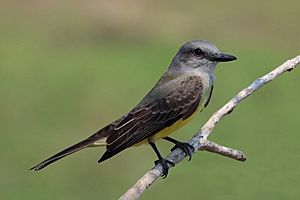Tropical kingbird facts for kids
The tropical kingbird (Tyrannus melancholicus) is a type of large tyrant flycatcher. These birds live and breed in many places, from southern Arizona and the Lower Rio Grande Valley in Texas, USA, all the way through Central America and South America. You can find them as far south as central Argentina and western Peru, and also on the islands of Trinidad and Tobago. Birds from the northern and southern parts of their home areas will migrate to warmer places after they have their young.
Quick facts for kids Tropical kingbird |
|
|---|---|
 |
|
| T. m. melancholicus The Pantanal, Brazil |
|
| Conservation status | |
| Scientific classification | |
| Kingdom: | |
| Phylum: | |
| Class: | |
| Order: | |
| Family: | |
| Genus: |
Tyrannus
|
| Species: |
T. melancholicus
|
| Binomial name | |
| Tyrannus melancholicus (Vieillot, 1819)
|
|
Contents
What Does a Tropical Kingbird Look Like?
A grown-up tropical kingbird is about 22 centimeters (8.7 inches) long. It weighs around 39 grams (1.4 ounces). Its head is a light gray color. It has a darker area around its eyes, like a mask. There's also a cool orange stripe on top of its head, called a crown stripe. Its beak is strong and gray.
The back of the bird is a grayish-green. Its wings and tail are brown. The tail is shaped like a fork. Its throat is light gray, which changes to an olive-colored green on its chest. The rest of its belly is bright yellow. Both male and female kingbirds look very similar. Young birds have light buff (pale yellowish-brown) edges on their wing feathers.
What Sounds Do Tropical Kingbirds Make?
The tropical kingbird has a high-pitched, chattering call. It sounds like tree-e-e-e-e-e-e. The male bird sings a more complicated song when the sun comes up in the morning.
Where Do Tropical Kingbirds Live and What Do They Eat?
Tropical kingbirds like to live in areas that are partly open, with some trees and bushes. This includes places like gardens and along roadsides. They often sit on high branches in trees. From these high spots, they can easily see what's happening around them.
These birds are very good at catching insects in the air. This way of hunting is called hawking. They will fly out from their perch, grab an insect, and then return. Sometimes, they also hover in the air to pick food off plants. This is called gleaning. Besides insects, they also enjoy eating some fruit.
How Do Tropical Kingbirds Protect Their Homes?
Tropical kingbirds are very brave and will defend their territory. They will chase away other birds that come too close. This includes much larger birds like toucans, caracaras, or even hawks. They are not afraid to stand up for their home!
Reproduction and Life Cycle
Tropical kingbirds build a simple cup nest in a tree. The female bird lays two or three cream-colored eggs. These eggs have reddish-brown marks on them. The female sits on the eggs to keep them warm, which is called incubation. This lasts for about 16 days.
Once the chicks hatch, they stay in the nest for about 18 to 19 more days. After this time, they are ready to leave the nest and fly on their own. This is called fledging.
Are Tropical Kingbirds in Danger?
The IUCN does not consider the tropical kingbird a threatened species. This means they are not in danger of disappearing. They are very common birds and can easily adjust to changes in their environment.
Images for kids
-
T. m. satrapa, Panama
See also
- Nesting Tyrannus melancholicus [1]
 In Spanish: Tirano melancólico para niños
In Spanish: Tirano melancólico para niños




